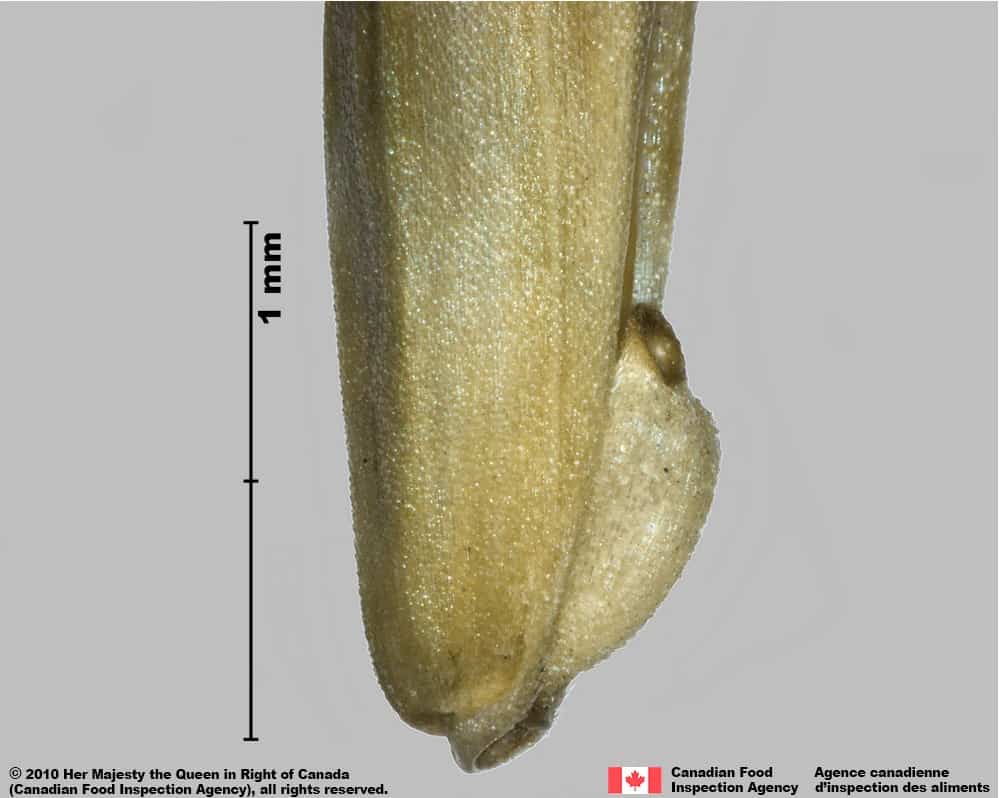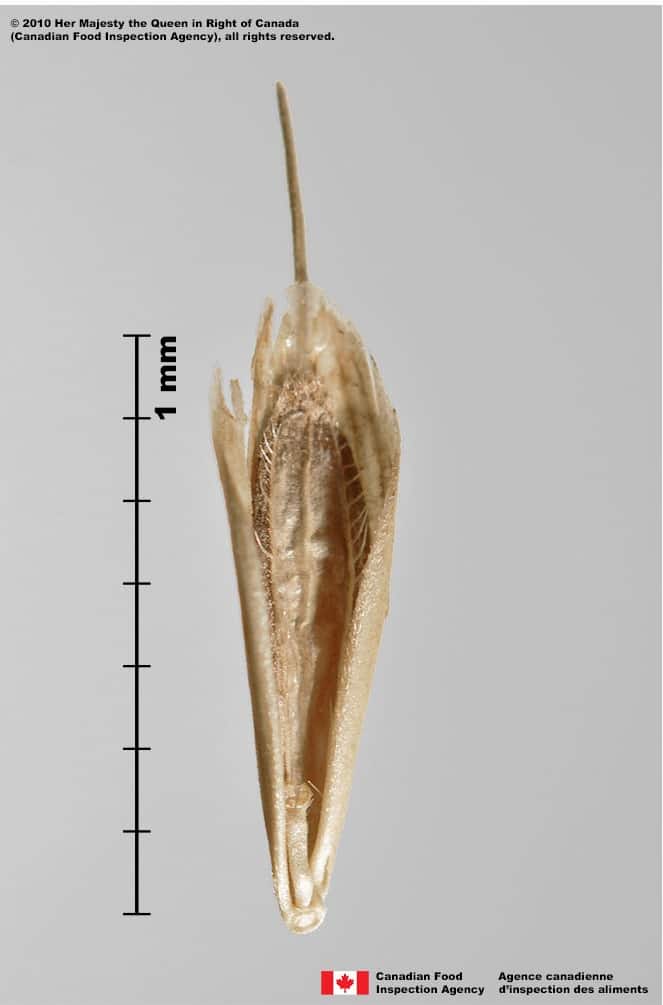Bromus secalinus
Overview
Aperçu
Regulation :
Remarques Réglementation:
- CFIA Weed Seeds Order - Class 3: Secondary Noxious Weed Seeds
- Quarantine lists of countries e.g. India *may be updated without notice
Regulation Notes:
Distribution :
Répartition :
Native to southern and eastern Europe, northern Africa and temperate Asia (USDA-ARS 2021). Introduced in Australia and North and South America, and common throughout most of the United States (Whitson et al. 1992; Barkworth et al. 2007; USDA-ARS 2021). Cultivated in the western United States (i.e., Oregon, Washington) (USDA-ARS 2021). Occurs in Alberta, British Columbia, New Brunswick, Nova Scotia, Ontario, Quebec and Yukon Territory (Brouillet et al. 2010+).
Habitat and Crop Association :
Habitat et Cultures Associées :
Cultivated fields, old fields, grassy places, slopes, shores, railway lines, roadsides, waste ground and disturbed areas (Darbyshire 2003; Barkworth et al. 2007). A weed of Triticum aestivum subsp. aestivum (common wheat) and Medicago sativa (alfalfa) fields (Davis 1993; Stone et al. 2001).
Economic Use, cultivation area, and Weed Association :
Utilisation économique, zone de culture et association de mauvaises herbes :
Duration of Life Cycle :
Durée du cycle vital:
Annual
Dispersal Unit Type :
Type d’unité de dispersion :
Floret
General Information
RENSEIGNEMENTS GÉNÉRAUX
Bromus secalinus was historically a serious weed of cereal crops, perhaps accidently harvested and planted with them (Georgia 2007). Its decline in the second half of the 20th century has been attributed to improvements in seed cleaning technology (Wilson and King 2003; Adamczewski et al. 2015).
It has recently re-emerged as a pest of Triticum aestivum subsp. aestivum (common wheat) in Europe, and minimum tillage practices are thought to promote this species (Adamczewski et al. 2015). B. secalinus occurs as a contaminant in cereal seeds (CABI 2021).
.Identification
Identification
-
Spikelet
Size
- Spikelet 10.0 – 20.0 mm long (Barkworth et. al. 2007)
Shape
- Spikelet egg-shaped, compressed in edge view
Surface Texture
- Spikelet surface is smooth
Colour
- Spikelet is shiny straw yellow
Other Features
- Spikelet has 4 – 9 florets (Barkworth et al. 2007)
-
Floret
Size
- Floret length*: 5.9 – 8.2 mm; width: 1.1 – 2.1 mm
*Note: minimum and maximum of 20 florets in a normal range of this species using image measurement (ISMA 2020)
Shape
- Long oval shaped floret with sides curled inward
Surface Texture
- Lemma and palea are smooth with several longitudinal nerves, the edges are generally granular and short-hairy
Colour
- Floret is shiny straw yellow
Other Features
Lemma awn
- Awns, if present, are straight and are attached near the top of the lemma
- Awn length*: 1.4 – 6.7 mm
*Note: minimum and maximum of 20 floret awns in a normal range of this species using image measurement (ISMA 2020)
Callus and Rachilla
- Rachilla is wedge-shaped
- Rachilla end is flattened with a circular scar and is curved towards the palea
Other features
- Palea is thick, and the caryopsis is not visible behind it
- Palea teeth have a broad base

Cheat (Bromus secalinus) florets








-
Caryopsis
Size
- Caryopsis length*: 6.0 – 7.5 mm; width: 1.8 – 2.0 mm
*Note: minimum and maximum of 5 caryopses in a normal range of this species using specimen measurement (ISMA 2020)
Shape
- Caryopsis is long oval shaped, thick, with edges curled inward or folded
Surface Texture
- Caryopsis is a smooth texture
Colour
- Caryopsis is reddish brown coloured
Other Features
- Caryopsis is generally the same length as the lemma and the palea
- A linear, black coloured hilum extends the length of the caryopsis

Cheat (Bromus secalinus) caryopsis



-
Embryo
Size
- Embryo is a rudimentary size compared to the caryopsis
Shape
- Embryo is oval or wedge-shaped and located at one end of the caryopsis
Endosperm
- Endosperm is hard and opaque white coloured
Identification Tips
CONSEILS POUR L’IDENTIFICATION
The florets of Bromus secalinus have a similar size and oval shape to other Bromus species such as B. japonicus and B. arvensis. The florets of B. secalinus are generally thicker and curled inwards or folded longitudinally compared to the flat, thinner florets of similar species such as B. japonicus and B. arvensis.

Bromus secalinus







Additional Botany Information
AUTRES RENSEIGNEMENTS BOTANIQUES
Similar Species
ESPÈCES SEMBLABLES
Similar species are based on a study of seed morphology of various species, and those with similar dispersal units are identified. The study is limited by physical specimen and literature availability at the time of examination, and possibly impacted by the subjectivity of the authors based on their knowledge and experience. Providing similar species information for seed identification is to make users aware of similarities that could possibly result in misidentification.
Bromus japonicus Houtt. (Japanese brome)
The florets of B. japonicus are generally longer (length*: 7.5 – 9.1 mm) with a longer awn (8.0 – 13.0 mm; Barkworth et al. 2007) as B. secalinus. The caryopsis is thin and edges rarely curl inwards compared to the thick caryopses of B. secalinus floret.
*Note: minimum and maximum of 10 florets in a normal range of this species using image measurement (ISMA 2020)
Click to select species
Cliquez pour sélectionner les espèces

Bromus japonicus
Comparison Window
Fenêtre de comparaison
MAIN SPECIES
ESPÈCES PRINCIPALES
Bromus secalinus

Bromus secalinus
Poaceae
Cheat (Bromus secalinus) florets
MAIN SPECIES
ESPÈCES PRINCIPALES
Bromus secalinus

Bromus secalinus
Poaceae
Cheat (Bromus secalinus) caryopsis (L) and florets
MAIN SPECIES
ESPÈCES PRINCIPALES
Bromus secalinus

Bromus secalinus
Poaceae
Bromus secalinus
MAIN SPECIES
ESPÈCES PRINCIPALES
Bromus secalinus

Bromus secalinus
Poaceae
Bromus secalinus
MAIN SPECIES
ESPÈCES PRINCIPALES
Bromus secalinus

Bromus secalinus
Poaceae
Bromus secalinus
MAIN SPECIES
ESPÈCES PRINCIPALES
Bromus secalinus

Bromus secalinus
Poaceae
Bromus secalinus
MAIN SPECIES
ESPÈCES PRINCIPALES
Bromus secalinus

Bromus secalinus
Poaceae
Cheat (Bromus secalinus); base of floret
MAIN SPECIES
ESPÈCES PRINCIPALES
Bromus secalinus

Bromus secalinus
Poaceae
Cheat (Bromus secalinus); base of floret, side view
MAIN SPECIES
ESPÈCES PRINCIPALES
Bromus secalinus

Bromus secalinus
Poaceae
Bromus secalinus
MAIN SPECIES
ESPÈCES PRINCIPALES
Bromus secalinus

Bromus secalinus
Poaceae
Cheat (Bromus secalinus) caryopsis
SIMILAR SPECIES
ESPÈCES SEMBLABLES
Bromus japonicus

Bromus japonicus
Poaceae
Japanese brome (Bromus japonicus); florets
SIMILAR SPECIES
ESPÈCES SEMBLABLES
Bromus japonicus

Bromus japonicus
Poaceae
Japanese brome (Bromus japonicus); floret
SIMILAR SPECIES
ESPÈCES SEMBLABLES
Bromus japonicus

Bromus japonicus
Poaceae
Bromus japonicus
SIMILAR SPECIES
ESPÈCES SEMBLABLES
Bromus japonicus

Bromus japonicus
Poaceae
Bromus japonicus
SIMILAR SPECIES
ESPÈCES SEMBLABLES
Bromus japonicus

Bromus japonicus
Poaceae
Bromus japonicus
SIMILAR SPECIES
ESPÈCES SEMBLABLES
Bromus japonicus

Bromus japonicus
Poaceae
Japanese brome (Bromus japonicus) floret; palea teeth
Need ID Help?
Besoin d’aide pour l’identification?
Reference(s)
Référence(s)
Adamczewski, K., Kaczmarek, S., Kierzek, R. and Urban, M. 2015. Germination biology and weed thresholds of rye brome (Bromus secalinus L.) in wheat (Triticum aestivum L.). Pakistan Journal of Agricultural Science 52: 989-995.
Barkworth, M. E., Capels, K. M., Long, S., Anderton, L. K. and Piep, M. B., (eds.) 2007. Volume 24. Magnoliophyta: Commelinidae (in part): Poaceae, part 1. Oxford University Press, New York, New York.
Brouillet, L., Coursol, F., Meades, S. J., Favreau, M., Anions, M., Bélisle, P. and Desmet, P. 2010+. VASCAN, the database of vascular plants of Canada. http://data.canadensys.net/vascan/ Accessed March 3, 2021.
Centre for Agriculture and Bioscience International (CABI). 2021. Invasive Species Compendium, CAB International, Wallingford, UK. https://www.cabidigitallibrary.org/journal/cabicompendium Accessed March 3, 2021.
Darbyshire, S. J. 2003. Inventory of Canadian Agricultural Weeds. Agriculture and Agri-Food Canada, Research Branch. Ottawa, ON.
Davis, L. W. 1993. Weed Seeds of the Great Plains: A Handbook for Identification. University Press of Kansas, Lawrence, Kansas.
Flora of North America (FNA) Editorial Committee, eds. 1993+. Flora of North America North of Mexico [Online]. 22+ vols. New York and Oxford. Accessed December 29, 2022.
Georgia, A. E. 2007. A Manual Of Weeds: With Descriptions Of All The Most Pernicious And Troublesome Plants In The United States And Canada; Their Habits Of Growth And Distribution, With Methods Of Control. Kessinger Publishing.
Global Biodiversity Information Facility (GBIF) Secretariat. 2022. https://doi.org/10.15468/39omei Accessed via https://www.gbif.org/species/2703717 Accessed December 29, 2022.
Government of Canada (GC). 2016. Canadian Weed Seeds Order. https://laws-lois.justice.gc.ca/eng/regulations/SOR-2016-93/page-2.html (English) https://laws-lois.justice.gc.ca/fra/reglements/DORS-2016-93/page-2.html (French)
International Seed Morphology Association (ISMA). 2020. Method for Seed Size Measurement. Version 1.0. ISMA Publication Guide. https://www.idseed.org/authors/details/method_for_seed_size_measurement.html
Stone, A. E., Peeper, T. F. and Solie, J. B. 2001. Cheat (Bromus secalinus) control with herbicides applied to mature seeds. Weed Technology 15 (2): 382-386.
U.S. Department of Agriculture-Agricultural Research Services (USDA-ARS). 2021. Germplasm Resources Information Network (GRIN), https://npgsweb.ars-grin.gov/gringlobal/taxon/taxonomysimple.aspx Accessed March 3, 2021.
Whitson, T. D., Burrill, L. C., Dewey, S. A., Cudney, D. W., Nelson, B. E., Lee, R. D. and Parker, R. 1992. Weeds of the West. Western Society of Weed Science, Jackson, Wyoming.
Wilson, P. and King, M. 2003. Arable Plants: A Field Guide. The Hanway Press, London, UK.




